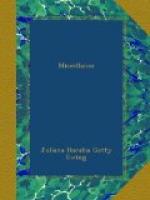Birch-wood makes good fuel. It is also used by cabinet-makers. Its uses in “little woods” are many. The charcoal is good for gunpowder, and it is that of which crayons are made. Birch-coppices are cut for brooms, hoops, &c., at five to six years old, and at ten to twelve for faggot-wood, poles, fencing, and bark for the tanners. Birch-spray (that is, the twigs and leaves) is used for smoking hams and herrings, and for brooms to sweep grass. It is also used to make birch-rods; but as we think very ill of the discipline of any household in which the children and the pets cannot be kept in order without being beaten, we hope our own young readers are only familiar with birch-rods in picture-books.
The (Sweet or Spanish) Chestnut (Castanca vesca) is grown in “little woods” for hop-poles, fence-wood, and hoops. The wood of the full-grown tree is also valuable.
Evelyn says, “A decoction of the rind of the tree tinctures hair of a golden colour, esteemed a beauty in some countries.” It would be entertaining to know if this is the foundation of the “auricomous fluids” advertised by hair-dressers!
Amongst “little woods” the dearest of all to the school-boy must surely be the hazel-copse! The Hazel (Corylus avellana) is never a large tree. It is, however, long lived, and of luxuriant growth. When cut it “stoles” or throws up shoots very freely, and when treated so will live a hundred years. With a single stem, Mr. Loudon assures us, it would live much longer. Filbert-hazels are a variety with longer nuts. Hazels are cultivated not only for the nuts, but for corf-rods,[1] hoops, fencing, &c., and hazel-charcoal, like beech-charcoal, is used for crayons. Like many other plants, the hazel has two kinds of flowers, which come out before the leaves. The long pale catkins appear first, and a little later tiny crimson flowers come where the nuts are afterwards to be.
Many old superstitions are connected with the hazel. Hazel-rods were used to “divine” for water and minerals by professors of an art which received the crack-jaw title of Rhabdomancy. Having tried our own hand at Rhabdomancy, we are able to say that the freaks of the divining-rod in sensitive fingers are sometimes as curious as those of a table among table-turners; and are probably susceptible of similar explanations.
The Larch (Larix Europaea, &c.). Though traceable in England for two hundred years, it is within this century that the larch has been extensively cultivated for profit. The exact date of its introduction from the mountain ranges of some other part of Europe is not known, but there is a popular tradition that it was first brought to Scotland with some orange-trees from Italy, and having begun to wither under hot-house treatment, was thrown outside, where it took root and throve thereafter. The wood of full-grown larch-trees is very valuable. To John, Duke of Athol, Scotland is indebted for the introduction of larch plantations




